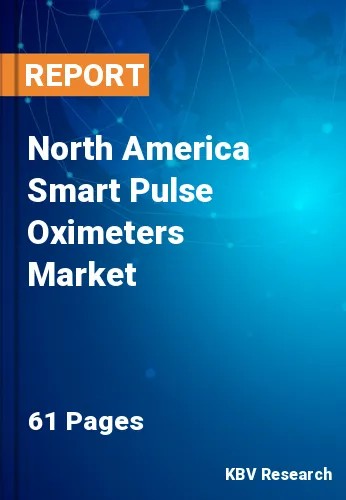The North America Smart Pulse Oximeters Market would witness market growth of 7.1% CAGR during the forecast period (2022-2028).
Pulse oximetry is a non-invasive way to check someone's oxygen saturation. The more accurate (and intrusive) reading of arterial oxygen saturation (SaO2) from arterial blood gas analysis is normally within 2% of peripheral oxygen saturation (SpO2) readings. However, the two are sufficiently connected that the pulse oximetry method is useful for detecting oxygen saturation in clinical settings since it is safe, simple, non-invasive, and affordable.
Transmissive pulse oximetry is the most prevalent method. A sensor device is placed on a thin area of the patient's body, typically a fingertip or earlobe, or an infant's foot, in this procedure. The blood flow rates in fingertips and earlobes are higher than in other tissues, allowing for better heat transfer. Two wavelengths of light are sent via the body part to a photodetector by the gadget. It determines the absorbances attributable to pulsing arterial blood alone, eliminating venous blood, skin, bone, muscle, fat, and (in most cases) nail polish, by measuring the changing absorbance at each of the wavelengths.
Asthma affects more than 25 million people in the United States by 2020. COPD has been diagnosed in around 14.8 million adults, with another 12 million persons likely to be diagnosed. Individuals, their families, schools, workplaces, communities, cities, and states are all affected by respiratory disorders. Thus, there is likely to be a growing demand for smart pulse oximeters from the hospitals and citizens of the region. Canada and the United States already have modernized healthcare sectors that quickly adopt new technology to provide better healthcare services to patients.
The federal government's healthcare spending in the United States climbed by 36.0 percent in 2020, compared to 5.9% in 2019. The COVID-19 pandemic accelerated the spread of the virus. Hospital spending is expected to rise by 6.4 percent to $1,270.1 billion in 2020, slightly higher than the 6.3 percent growth in 2019. The region's high incidence of COPD, asthma, and heart diseases as well as rising government spending on modernizing the healthcare sector, are projected to make it a fertile field for the smart pulse oximeters market.
The US market dominated the North America Smart Pulse Oximeters Market by Country in 2021, and would continue to be a dominant market till 2028; thereby, achieving a market value of $668.5 Million by 2028. The Canada market is experiencing a CAGR of 9.6% during (2022 - 2028). Additionally, The Mexico market would exhibit a CAGR of 8.6% during (2022 - 2028).
Based on Type, the market is segmented into Fingertip, Hand held, Wrist worn, and Pediatric. Based on End User, the market is segmented into Hospitals & Clinics, Ambulatory Surgical Centers, and Home Environment. Based on countries, the market is segmented into U.S., Mexico, Canada, and Rest of North America.
Free Valuable Insights: The Global Smart Pulse Oximeters Market is Estimated to reach $2.4 Billion by 2028, at a CAGR of 7.6%
The market research report covers the analysis of key stake holders of the market. Key companies profiled in the report include Masimo Corporation. Koninklijke Philips N.V., Medtronic PLC, Omron Corporation, Smiths Group PLC, Contec Medical Systems Co., Ltd., Meditech Equipment Co .,Ltd (Meditech Group), Nonin Medical, Inc., Promed Technology Co., Ltd., and Tenko Medical System Corp.
By Type
By End User
By Country
Our team of dedicated experts can provide you with attractive expansion opportunities for your business.

